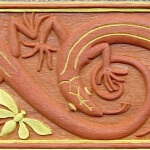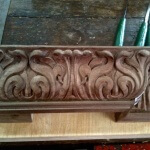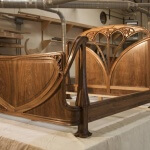The term Art Nouveau comes from the Maison de l’Art Nouveau, a Parisian art gallery and shop that opened in 1895. Developed in Europe and North America in the late 19th and early 20th centuries, the style was unencumbered by rules and historical traits.
Art Nouveau was described during Paris’ Exposition Universelle of 1900, a world’s fair, as the first new style of the 19th century. In many ways, Art Nouveau was a result of the Industrial Revolution, and was created and driven by a wave of dynamic new designers and artists. Its carefree architectural forms took curving and organic sinuous lines, vibrant leaves and flowers and integrated them into arts and crafts.
Art Nouveau is often considered a sub-style of Arts and Crafts, and it borrows heavily from the philosophy of William Morris. Morris started the Arts and Crafts Movement in England in the mid-19th century. He was instrumental in transforming everyday objects into fine art by applying individual creativity to the highest levels of craftsmanship and shunning mass-produced, machine-made items. Art Nouveau is also influenced by art from Japan, China and the Islamic cultures, with their dynamic lines, stylized forms, woodblock prints and technical skills.
Art Nouveau is a wonderfully free-spirited style. At Agrell Architectural Carving, we have recreated its organic elegance in fire surrounds, panels and furniture.
Check out designs for our historically accurate Art Nouveau-style room.
- Art Nouveau panel with fish and seaweed, based on a design by M.P. Verneuil and hand-carved by Agrell Architectural Carving.
- Lizard design by M.P. Verneuil. Hand-carved and painted by Agrell Architectural Carving.
- Art Nouveau cyma recta moulding, designed and hand-carved in walnut by Agrell Architectural Carving.
- Art Nouveau fire surround, designed and hand-carved in mahogany by Agrell Architectural Carving.
- Art Nouveau bed based on a Louis Majorelle design, built and hand-carved in walnut by Agrell Architectural Carving.
- Art Nouveau bed based on a Louis Majorelle design, built and hand-carved in walnut by Agrell Architectural Carving.
(Source: Handbook of Ornament by Franz Sales Meyer)







